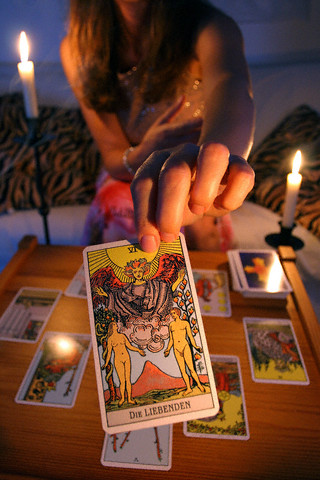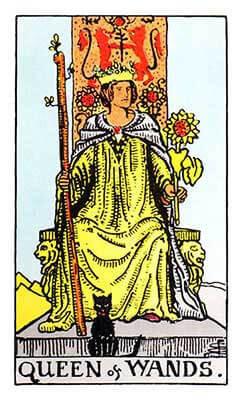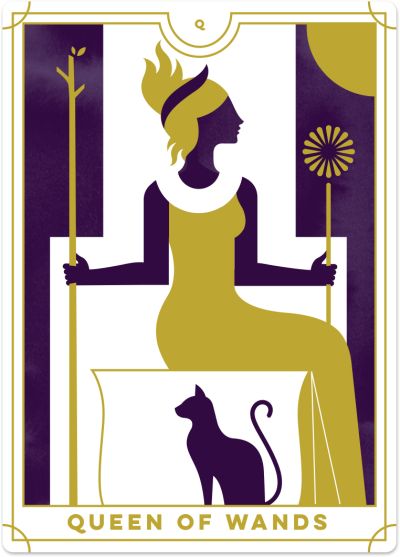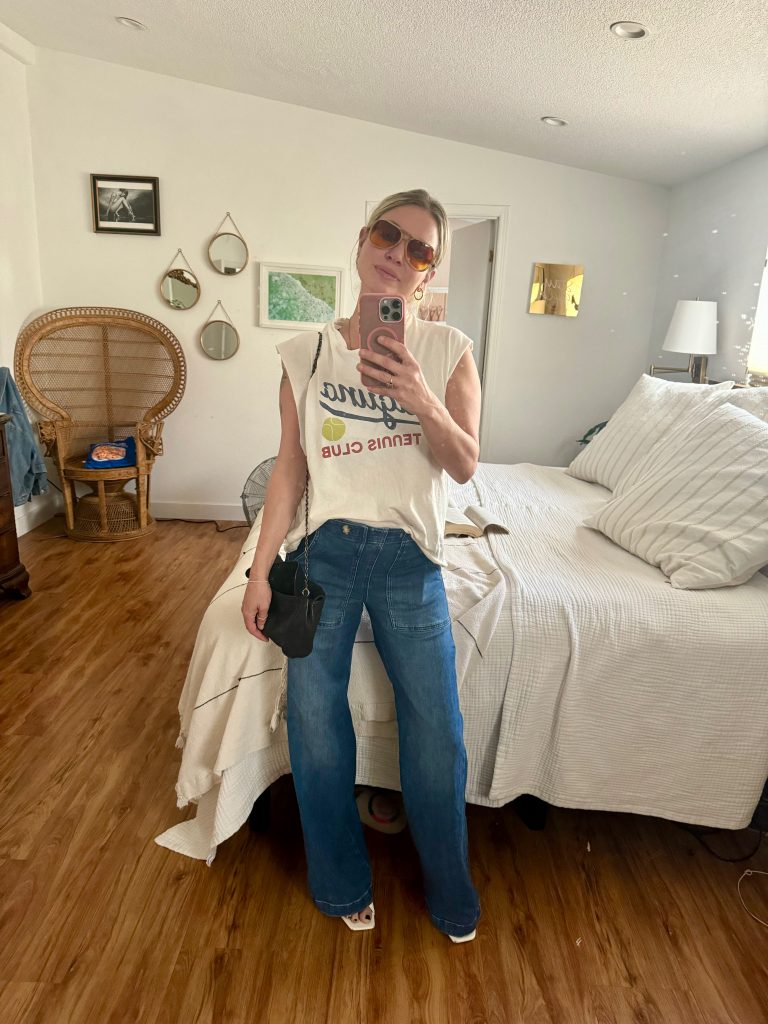
Meet Jessica, RG’s brand-new Tarot contributor. I’ve always been a huge fan of Tarot – you can check out my post about a reading Jessica did for me here – but don’t know a ton about how it actually…works. So I thought it’d be fun to ask Jessica to help us figure it out together. She’ll be doing a series on Tarot in the weeks to come, so if you have any questions for her, now’s your chance 
![]()
Let’s get straight to the point: It’s entirely possible that you think Tarot is bullshit. And you know what? That’s all right with me. But I would love the chance to change your mind.
Sure: The fact of the matter is that Tarot, like every other deck of cards you’ve ever held in your hands, is nothing more than a collection of pictures printed on paper. Although there are records of Tarot cards being used for divination as early as the 18th century, these cards were mostly used for games, not cartomancy. It was the publication of the Smith-Waite deck (the one that’s likely the most familiar to you) that popularized the use of Tarot as an occult tool.
So while Tarot cards have a long history, it’s difficult to make the argument that they are a pure relic of timeless teachings. I don’t claim to be able to see into the future with Tarot cards; I don’t believe that Tarot offers simple answers to complex problems; I would definitely be bullshitting if I professed that Tarot gives me access to ancient wisdom that’s hidden from most mere mortals. But those pictures on paper have inspired a culture of interpretation that has evolved and grown more layered and more diverse over time, turning Tarot into something that’s as rich as you want to make it.
In other words: Tarot isn’t magic. And that doesn’t take away from their power in the slightest. Tarot cards don’t have to draw on a misty heritage or the supernatural to be wonderful tools for self-discovery. The beauty of Tarot is that it coaxes us to step outside the cycle of thoughts that usually runs on repeat in our heads, and take a moment to look through another window into our lives. Through that window we see the problems and worries that nag at us, sure, but we also find strengths we may not yet recognize and opportunities we might otherwise have missed. Tarot might not be able to give us glimpses of the future, but it does help us take a deep look into the now.
If nothing else, these pictures printed on paper invite us to sit still for a moment and, very simply, see what we see.

Smith-Waite’s Queen of Wands
Let’s take a peek at how it works by reading a single card that I drew just for this post.
The card I drew: The Queen of Wands.
The personal significance: The fact that I drew this particular card was striking to me because The Queen of Wands is the name of my Tarot business, and it is through this business that I came to know Jordan…which in turn led to my coming on board as a columnist for RG. (Weird? Weird. I said that Tarot wasn’t magic. I never said that it isn’t occasionally weird.)
The meaning of the card itself: The Queen of Wands is a court card – Page, Knight, Queen, or King – from the Minor Arcana. If you see Tarot represented in popular culture, you’ll probably see members of the Major Arcana – Death, The Devil, The Sun, The Star – which are archetypes that speak to us of existential matters. The Minor Arcana is, like a deck of playing cards, divided into four suits, and mostly deals in the everyday. If we look at the cards from Ace to King as a journey through each suit, the Queen represents someone who has worked through the challenges of that suit to come into her power.
The suit of Wands is framed around the concept of transforming ideas into realities, and so we see that the Queen of Wands has learned enough about inspiration and manifestation to achieve sovereignty in these areas. The sunflower in her left hand is a symbol of consciousness and vitality. The pyramids in the background suggest that the Queen of Wands has access to ancient wisdom—but their shape also echoes the alchemical symbol for fire, which is the element that rules the Wands. You may notice the felines: the lions woven into the cloth of state hanging behind the Queen, the stone lions flanking her throne, and the black cat sitting before her. As peak predators, lions have long represented royalty. But to me, the skinny black cat evokes a familiar.
Because – of course – the Queen of Wands is a witch.

Another interpretation of the Queen of Wands
How the Tarot goes deeper: In a reading, I would ask my client whether this card represents a person – maybe themselves – or speaks to a dynamic in their lives, and I would consider how this card interacts with the cards around it. As a single card I’ve drawn for guidance today, I might ask myself whether I need to look for a Queen of Wands in a mentor or friend, or how I might harness Queen of Wands energy to do the work that’s before me right now. All of this, of course, is only scratching the surface of what we can learn when we sit with any card.
Now that you’ve read this far – and now that I’ve presented all my caveats – I will confess that I wasn’t quite telling the truth when I said that the Tarot isn’t magic. It’s just that I believe – paradoxically – that the best way to access the magic of Tarot is to not expect magic.
Or, to put it another way: The magic is in us.
The simple fact that I drew the Queen of Wands – the card that serves as my professional alter ego and represents what I have created for myself and my clients – in the service of introducing myself to an entirely new community (yes, I mean you) is precisely the sort of awesome weirdness that Tarot can deliver when we create a space for it.
I’ve been getting to know Tarot since I was a fantasy-reading nerd in the 1980s, and have found it to be a wonderful tool for meditation and self-discovery. Sometimes the cards are so on-the-nose that they’re basically just the universe saying, “Duh.” Sometimes the cards are so perfectly contrary that it’s like the cosmos giving me the finger. Often, the cards push me farther than I want to go, and every once in awhile they get tired and cranky and refuse to help me at all. These pictures, in all their many incarnations, have become a partner in my personal evolution, and in my journey as a guide for others.
I’ve been honored and humbled by the folks who have let me read for them. I’m so excited to be writing about Tarot for Ramshackle Glam, and I have a million things I want to share, but what I really want to know is what you want.
An introduction to different approaches to Tarot?
Tips for developing a personal practice?
A guide to Tarot decks and other resources?
Or – just an idea – a reading for an RG reader (you?), which I can then post here – with permission – to show you how, precisely, it’s done?
The end of the summer is upon us. It’s an ideal time to go deep into the shadows of our own psyche, and Tarot can help us shine a light into the darkness.
Where do you want go next? Tell me. I want to know.
– Jessica
About Jessica Jernigan: After majoring in Religion at Bryn Mawr College, Jessica sold books and tended bar until she found a career in corporate marketing (this was not a perfect fit). These days, Jessica makes her way reading books and Tarot cards and writing about both.






